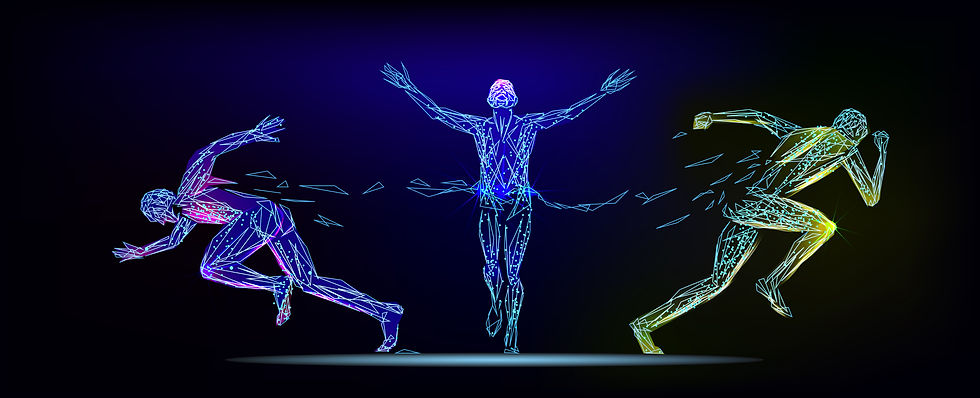Do you know that emotions can affect your skeleton?
- Dr. Ani

- Aug 22, 2021
- 6 min read
Usually, we think of our bones and skeleton as something very sturdy and resistant to change. However, there is nothing further from the truth. Our skeleton consists of 206 bones connected with ligaments and muscles, which act as one unified whole.

This means that if a change occurs in one part of the skeleton, that change affects the entire anatomical construct. For example, you can have foot pain, but your foot pain might be originated from a misaligned structure in your neck. Therefore, unless you address your neck problem you might not be able to resolve your foot problem. Your foot and your neck are related through your skeletal framework. In fact, any bone in your body is related to all other bones you have. Imagine your skeleton constructed by all bones in it, as a bee hive. All bees are separate, but they live, act and interact together as one whole. No bee can live without its hive. When one bone moves out of alignment, all other bones start shifting in all kinds of different directions to compensate for the original movement.
It is important to note that some of your bones play a more significant role in the vertical alignment of your body than others.
Your skeleton is the carrier of all body weight and it is the protector of your internal organs. Therefore, it is easy to understand that bones situated closest to your skeletal midline such as your vertebrae, pelvic, and breast bones have a bigger impact on your bodily alignment, than bones situated in the periphery of your body, such as those of your fingers.

The question remains: How is this possible and what exactly occurs in our skeleton when a powerful emotion strikes?
To answer this question, let’s examine our daily lives together. We all know that almost every living human being on this planet is exposed to large amount of daily stress. Each human being reacts in a unique way to this stress. Psychology and sociology researchers have extensively studied the human reactions to stress and have developed different working theories about them. I believe, that all current theories have intrinsic value but the greatest breakthrough came from a theory developed by the Harvard’s psychologist, Walter Cannon, who managed to boil down the immense diversity of human reactions in the face of danger to two basic concepts- to escape the danger or to stay and face the danger.
Famously, Dr. Cannon named those choices: the “fight or flight reactions”.
He discovered that during either of these reactions, our bodies adapt by shutting down their digestive and reproductive functions (which are not as essential to survival as other bodily function when faced with acute danger). In addition, our heart rates increase in order to pump fresh blood and oxygen to the muscles and the brains (needed to escape or to fight). Also, our peripheral blood vessels constrict (we get pale and our limbs get cold since blood is shifted from the skin to the important internal organs). After the danger (the stressor) has resolved all bodily functions should slowly return back to normal.
However, during a chronic (repetitive) stress, as often provided to us by our modern society, the body becomes unable to release from the survival posture and we start to live in a “chronic survival mode”. Hence, people under chronic stress could develop and sustain high blood pressure (needed to deliver us out of danger or to fight the danger), high blood sugars (for the same reasons), sleep problems (you have to be vigilant in order to detect danger), chronic fatigue (due to overuse of the adrenal glands in pumping extra adrenaline in our system), premature aging (the system wears out when running constantly at perpetual maximum speed), and myriad of other health problems.
In recent years, research on stress-induced diseases, has discovered that our skeleton also reacts to danger by shifting its bones in specific positions.
Imagine a fighter assuming a combat position: the chest and the pelvis are curved in and the legs are apart and bent with both hands fisted in front of the chest. Living in a chronic stressful state might lock all our bones in a “chronic fighting position” which might generate health problems, such as pain, organ dysfunctions, and others.

So, what are the skeleton’s stress reaction moves? Here is a list:
The tailbone (coccyx) moves forward (dogs have their tail between their legs,
when assuming a defense posture).
The breast bone (sternum) moves up to protect the heart and the lungs.
The xiphoid (the bone hanging down at the end of the breast bone), which is related to
our breathing process stops moving (we hold our breath during danger, not to be
detected by the enemy).
The larynx (the talking box) moves upwards (some people loose their voice during
danger - we should be very quiet not to be detected by the enemy).
The symphysis (the pubic bone) moves upwards (likely because the body curves
into a fighting position).
The question is: why is all this important?
It is important, because when you assume “fight or flight” positions, you usually experience very intense emotions, such as fears, anger etc. The body creates a connection between the emotion and the skeleton posture and “locks them together”. Therefore, you not only hold the body posture, but you also hold the related emotions into your bones.
I will go one step further. Researchers have established that when one assumes a particular posture, this could induce an emotion which was not felt by the person before assuming the posture. Wow, wow, wait a minute, are you telling me that the skeleton can create emotions? Yes, this is what I am telling you, tough the better word is not “create” but rather “extract” or “induce”. In other words, a particular posture can bring to the surface something that has been already established before. Why - because from the first day of our lives, our brain has been mapping the connections between postures and emotions. For example, if somebody is standing in front of you with tight fists and wide open low body stance it is unlikely that, this person is experiencing feelings of love towards you. You might need to run away or to fight in order to preserve your life. The truth is that our bodies are expert posture-emotion match makers, thought we are rarely conscious of these ongoing, daily assessments.

I realize that it may feel frightening to some, to hear that we carry our emotions locked all over us, but there is good news - something can be done - the chronic skeletal stress posture is correctable. Ah, how nice!
So, where do we go from here? We do not need to go anywhere, because a chiropractor by the name of Tedd Koren solved the problem for us by creating a technique called – Koren Specific Technique – or KST, capable of correcting chronic skeletal posture/emotional patterns.
The technique is performed by hand with no tools or with the help of a hand-held device called ArtroStim™.

There are many recorded testimonies of practitioners using the technique and of patients treated with KST showing an immediate skeletal (and the related to the misalignment symptoms) and an emotional release (in many cases).
At this point of time, you are maybe asking yourself: how and where can I find a practitioner skillful in this technique?
First, you need to know that each year Dr. Koren offers weekend-long training courses on both costs of the USA for any medical or body therapists. Here is the website of Dr. Koren for a reference: www.korenspecifictechnique.com and www.korenwellness.com
Of course, there are already registered chiropractors, medical doctors and other health practitioners who have been already trained. You can, and find one close to your zip code and book an appointment on the Internet.
Enjoy this delicious piece of knowledge, as I do.
From my heart to yours,
Dr. Ani
Disclaimer:
Though I am a medical doctor and I share my experience and knowledge with you, please be advised that I am not your medical doctor, so you will need to seek and follow the directions of the medical professionals involved in your case. This article is purely informational and cannot be taken as medical advice.
In the box below you can type a comment. If you do, you will be asked to sign with your name and email. This is necessary to avoid robotic abuse of the web. I will never misuse your data. Your will not receive monthly updates unless you chose to subscribe. Thank you.





Comments